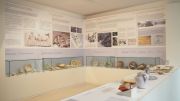This is the last room of the museum and represent the Renaissance phase of Camaiore, that was transformed from the fortified village of the 14th century, into a city in the 19th century.
During the Renaissance period numerous palaces are built and these ones substitutes the middle-age house-towers, while the village specializes in craft activities such as the production of Slipware, which is a kind of pottery identified by its decorating process, where slip is placed onto the clay body surface before firing by dipping, painting or splashing.
Palazzo Tori Massoni, which is the headquarter of this museum, was built in this period.
In this showcases are exposed numerous potteries founded in various buildings of the historic city center, from the archaic majolicas till the potteries of the late 18th century.
The activities linked to the exploitation of the mountainous areas, such as farming, chestnuts harvesting, cheese and butter working, wool, silk and hemp working for fabrics, and the use of mills and crushers along the river “Lombricese”.
The last part of this virtual journey through Camaiore’ s history concerns the passage from the illuminated writing to the invention of the Movable type in the 15th century.
It’s important to mention Ludovico Marracci, who was from Torcigliano (Camaiore).
He was a Professor Emeritus in the Roman Curia at Vatican, and author in the 17th century of the first translations of the Bible in Arabic and of the Quran in Latin.







